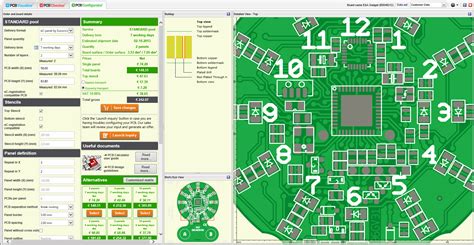PCB Size and Complexity
The size and complexity of a PCB are among the most significant factors that impact its price. Larger PCBs require more materials and take longer to manufacture, resulting in higher costs. Similarly, complex designs with intricate layouts, multiple layers, and high component density also increase the price.
PCB Size Categories and Pricing
| Size Category | Dimensions (inches) | Approximate Price Range |
|---|---|---|
| Small | < 2 x 2 | $5 – $20 |
| Medium | 2 x 2 to 4 x 4 | $20 – $50 |
| Large | 4 x 4 to 8 x 8 | $50 – $100 |
| Extra Large | > 8 x 8 | $100+ |
Note: Prices are for reference only and may vary based on other factors.
Number of Layers
PCBs can have varying numbers of layers, ranging from single-sided to multi-layered boards. The number of layers directly affects the cost of the PCB, as each additional layer requires more materials, processing time, and expertise.
PCB Layer Count and Pricing
| Number of Layers | Approximate Price Multiplier |
|---|---|
| 1 (Single-sided) | 1x |
| 2 (Double-sided) | 1.5x – 2x |
| 4 | 2x – 3x |
| 6 | 3x – 4x |
| 8+ | 4x+ |
Note: Price multipliers are for reference only and may vary based on other factors.
PCB Material
The choice of PCB material also plays a role in determining the price. The most common PCB materials are FR-4, which is a glass-reinforced epoxy laminate, and aluminum. FR-4 is the standard material for most applications, while Aluminum PCBs are used in specific cases where better heat dissipation is required.
PCB Material Pricing Comparison
| Material | Approximate Price Compared to FR-4 |
|---|---|
| FR-4 | 1x |
| Aluminum | 1.5x – 2x |
Note: Prices are for reference only and may vary based on other factors.

Quantity and Batch Size
The quantity of PCBs ordered and the batch size also influence the price per unit. Larger quantities and batch sizes generally result in lower per-unit costs due to economies of scale. Manufacturers can offer discounts for bulk orders as they can optimize their production processes and minimize setup costs.
PCB Quantity Discounts
| Quantity | Approximate Price Discount |
|---|---|
| 1 – 10 | 0% |
| 11 – 50 | 5% – 10% |
| 51 – 100 | 10% – 15% |
| 101 – 500 | 15% – 20% |
| 501 – 1000 | 20% – 25% |
| 1000+ | 25%+ |
Note: Discounts are for reference only and may vary based on other factors.
Surface Finish
The surface finish of a PCB is another factor that affects its price. The most common surface finishes are Hot Air Solder Leveling (HASL), Organic Solderability Preservative (OSP), and Electroless Nickel Immersion Gold (ENIG). Each surface finish has its own advantages and cost implications.
PCB Surface Finish Pricing Comparison
| Surface Finish | Approximate Price Compared to HASL |
|---|---|
| HASL | 1x |
| OSP | 1.1x – 1.2x |
| ENIG | 1.3x – 1.5x |
Note: Prices are for reference only and may vary based on other factors.
Minimum Hole Size and Trace Width
The minimum hole size and trace width of a PCB design also impact its price. Smaller hole sizes and narrower trace widths require more precise manufacturing processes, which can increase the cost. PCB manufacturers often have standard minimum hole sizes and trace widths, and deviating from these standards may result in higher prices.
PCB Minimum Hole Size and Trace Width Pricing Impact
| Minimum Hole Size / Trace Width | Approximate Price Impact |
|---|---|
| Standard (8 mil / 8 mil) | None |
| Reduced (6 mil / 6 mil) | +10% – 15% |
| Fine (4 mil / 4 mil) | +20% – 30% |
| Ultra-Fine (2 mil / 2 mil) | +30% – 50% |
Note: Price impacts are for reference only and may vary based on other factors.
Turnaround Time
The turnaround time, or the time required to manufacture and deliver the PCBs, is another factor that influences the price. Faster turnaround times often come with a premium, as manufacturers need to prioritize and expedite the production process.
PCB Turnaround Time and Pricing
| Turnaround Time | Approximate Price Premium |
|---|---|
| Standard (2-3 weeks) | None |
| Fast (1-2 weeks) | +10% – 20% |
| Expedited (3-5 days) | +30% – 50% |
| Same Day | +100% or more |
Note: Price premiums are for reference only and may vary based on other factors.
Design Complexity and Additional Features
The overall design complexity and any additional features required can also impact the price of a PCB. Some examples of additional features that may increase the cost include:
- Blind and buried vias
- Controlled impedance
- High-density interconnect (HDI)
- Flex or Rigid-flex PCBs
- Solder mask color options
- Silkscreen color options
The cost impact of these features varies depending on the specific requirements and the manufacturer’s capabilities.
Manufacturer and Location
Finally, the choice of PCB manufacturer and their location can also affect the price. Manufacturers in different regions may have varying labor costs, material costs, and overhead expenses, which can influence the final price of the PCBs. It’s essential to consider factors such as reputation, quality, and customer support when selecting a PCB manufacturer, in addition to the price.
PCB Pricing by Region
| Region | Approximate Price Compared to North America |
|---|---|
| North America | 1x |
| Europe | 1.1x – 1.3x |
| China | 0.5x – 0.8x |
| Taiwan | 0.7x – 0.9x |
| India | 0.6x – 0.8x |
Note: Prices are for reference only and may vary based on other factors.
Frequently Asked Questions (FAQ)
- Q: How can I reduce the cost of my PCB project?
A: To reduce the cost of your PCB project, consider the following: - Optimize your design for manufacturability
- Use standard materials and surface finishes
- Increase the quantity or batch size
- Choose a slower turnaround time
-
Consider offshore manufacturers with lower costs
-
Q: What is the most cost-effective PCB material?
A: FR-4 is the most cost-effective and widely used PCB material for most applications. It offers a good balance of mechanical, electrical, and thermal properties at a reasonable price. -
Q: How does the number of layers affect the price of a PCB?
A: The price of a PCB increases with each additional layer. This is because more layers require more materials, processing time, and expertise to manufacture. A multi-layer PCB can cost several times more than a single-sided or double-sided board. -
Q: Is it always cheaper to order PCBs in larger quantities?
A: In most cases, yes. Ordering PCBs in larger quantities results in a lower per-unit cost due to economies of scale. Manufacturers can offer discounts for bulk orders as they can optimize their production processes and minimize setup costs. -
Q: How does the location of the PCB manufacturer affect the price?
A: The location of the PCB manufacturer can affect the price due to varying labor costs, material costs, and overhead expenses in different regions. Manufacturers in countries like China and India often offer lower prices compared to those in North America or Europe. However, it’s essential to consider factors such as quality, reliability, and shipping costs when choosing a manufacturer based on location.
In conclusion, the real price of PCB boards is influenced by a combination of factors, including size, complexity, number of layers, material, quantity, surface finish, minimum hole size and trace width, turnaround time, design complexity, and manufacturer location. By understanding these factors and making informed decisions based on your specific requirements and budget, you can optimize the cost of your PCB project without compromising on quality and reliability.
